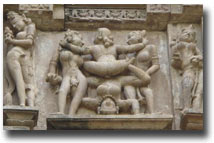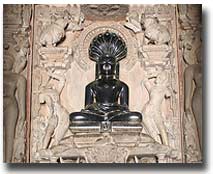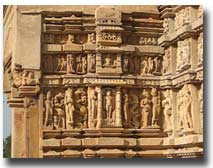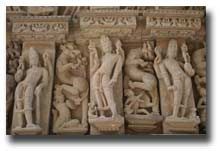Location :
Significance of the Temple
Khajuraho Temples has been recognized by UNESCO as a place of world heritage on account of its magnificent temples. These temples of Khajuraho are generally divided into three groups: Western, Eastern and Northern parts. The Eastern group mainly consists of Jain temples. All together there are 34 (Thirty Four) Jain Temples in total. As in the sense from architectural point of view the Parsvanath, the Adinath and the Shantinath temples are relatively more important and noteworthy. These temples are unique examples of religious harmony and spirit of accommodation.The famous Shantinath is known for its 14 feet high standing idol, the 16th jain tirthankar. According to an inscription on it, it was installed in Vikrama-Samvat 1085 (1028 AD). This idol is full of miracle. About 400 years ago, while invaders (idol breakers) came here and applied hammer to the little finger to break the idol, flow of milk started from it and at the same time dense flock of honey bees attached on invaders and pushed them to run away. Desires of devotees are been fulfilled here after prayer and worship full of faith.

Third is the Adinath temple located on the right of the Parsvanath, which is a beautiful - though small shrine. It is noted for its simple but well- ornamented 'Shikhar' (spire) and the three bands of sculptures on its semi-circular outer wall containing figures of Gandharvas and Kinnars (celestial musicians) and Vidyadharas, various Yakshas (Gods attending on Tirthankaras) and Apsaras (celestial fairies). The figures of "Govadan" (or "Gomukh") - the attendant Yaksha of Lord Risabhadev has been conspicuously carved-out. This temple has got the rare sculptures of sixteen Digambar Jain Vidyadevis - which have been very carefully carved out by the master-artist of Khajuraho, who has taken much care and great pains to depict these goddesses along with their 'Vahanas' (vehicles) and 'Ayudhas' (weapons) and the necessary 'Parikar' (background). There are 31 another jain temples with beautiful architecture and idols.
This great temple is also been privileged to possess the best art pieces of Sura- Sundaris (Divine Nymphs) in various attractive postures. Such things cannot be unnoticed by visitors or the devotees here. This temple is a 'Panchayatan type' of temple in Nagar style; as it has got all the five organs thereof i.e. Ardha-Mandap, Mandap, Maha-Mandap, Antaral and Garbhagriha (Sanctum).
Western Group:
Kandariya Mahadeo

Chaunsath Yogini
This temple is the earliest temple of this group that has survived. It belongs to 900 AD and is dedicated to Goddess Kali. It has the distinction of being the only granite temple here.
Chitragupta Temple
The Chitragupta Temples is dedicated to the Sun God (Surya Dev). It faces towards east or the rising sun and the imposing image of the deity in the inner sanctum is as high as five feet and is shown driving a horse-drawn chariot. It is in front of this temple and the Vishwanatha temple that most of the dance performances take place during the Khajuraho Dance Festival.
Vishwanatha Temple
Vishwanath temple has an impressive entrance with magnificent stone guarding its northern steps and royal masonry elephants taking care of the southern steps. The three-headed image of Lord Brahma in the temple is not less captivating.
Lakshmana Temple

Matangeshwara Temple
Matangeshwara Temple is situated outside the premises of Western group of temples, this temple is dedicated to Lord Shiva's temple which is known for the daunting eight-feet high lingam (male organ representing the natural process of reproduction and the continuity of human life form) that it enshrines.
Eastern Group:
Ghantai Temple
This Jain temple has remarkable and exciting frescos depicting the 16 dreams of the mother of Lord Mahavira at the time of his birth and a Jain goddess mounted on a winged Garuda. The Adinatha Temple is richly ornamented with delicate and pretty scultures including those of yakshis. It is dedicated to the first Jain tirthankara (saint), Adinath.Most of the temple here belong to Jain faith but there are three Hindu temples of the group, namely, the Brahma temple enshrining a four-faced linga; the Vamana temple with divine carvings of sensuous celestial maidens in various poses adorning its outer walls and the Javari temple with a opulently carved doorway and ostentatious sculptures on its exteriors.
Parsvanatha Temple
The Parsvanath temple is famous in the world as it contains some of the most excellent sculptures of Khajuraho e.g. figures of Lakshmi-Narain, Balram-Reoti, eight Dikpalas (i.e. Indra, Agni, Yama, Nirriti, Varuna, Vayu, Kuber and Isan), Ambika, Kamdev Rati, Ram-Sita along with Hanuman. It is one of the largest Jain temple of the Eastern group having the intricate stone carvings, especially, the sculptures on the northern outer wall of the temple are certainly praiseworthy. It enshrines a throne facing the bull emblem that represents the the first tirthankara, Adinatha.
Southern Group:
Duladeo Temple is a Shiva temple which is known for flaunting the striking images of the celestial maidens or apsaras and richly ornamented figures.
| Chaturbhuja Temple- It has the huge imposing intricately carved image of Lord Vishnu in the temple's sanctum, which is the chief attraction of the temple. | Nearby tourist places to Khajuraho Jain Temple
Gwalior Bhopal Indore |  |
How to reach the Temple
- Through Roadways: Khajuraho is connected by regular buses with Satna (117km, 4hrs), Harpalpur (94km), Jhansi (172km) and Mahoba (61km). Khajuraho is located 600km (11hrs journey) south West of Delhi. There are bus services from Agra (12 hrs), Gwalior (9hrs) and Jhansi.
-
Through Railways: The nearest rail heads are Harpalpur (94km) and Mahoba (61km, 2 1/2 hrs). Jhansi (172km/ 5 1/2 hrs) is a convenient rail head for those travelling from Delhi and Chennai; Satna (117km, 4hrs), on the Mumbai-Allahabad line of the Central Railway for those coming from Mumbai, Kolkata and Varanasi.
- Through Airways: services link Khajuraho airport with Delhi, Agra and Varanasi.



